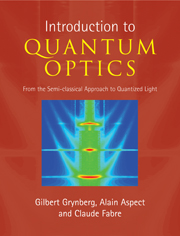Book contents
- Frontmatter
- Contents
- Foreword
- Preface
- Acknowledgements
- Part I Semi-classical description of matterlight interaction
- 1 The evolution of interacting quantum systems
- Complement 1A: A continuum of variable width
- Complement 1B: Transition induced by a random broadband perturbation
- 2 The semi-classical approach: atoms interacting with a classical electromagnetic field
- Complement 2A: Classical model of the atom-field interaction: the Lorentz model
- Complement 2B: Selection rules for electric dipole transitions. Applications to resonance fluorescence and optical pumping
- Complement 2C: The density matrix and the optical Bloch equations
- Complement 2D: Manipulation of atomic coherences
- Complement 2E: The photoelectric effect
- 3 Principles of lasers
- Complement 3A: The resonant Fabry–Perot cavity
- Complement 3B: The transverse modes of a laser: Gaussian beams
- Complement 3C: Laser light and incoherent light: energy density and number of photons per mode
- Complement 3D: The spectral width of a laser: the Schawlow–Townes limit
- Complement 3E: The laser as energy source
- Complement 3F: The laser as source of coherent light
- Complement 3G: Nonlinear spectroscopy
- Part II Quantum description of light and its interaction with matter
- Part III Applying both approaches
- Index
Complement 3B: The transverse modes of a laser: Gaussian beams
Published online by Cambridge University Press: 05 August 2012
- Frontmatter
- Contents
- Foreword
- Preface
- Acknowledgements
- Part I Semi-classical description of matterlight interaction
- 1 The evolution of interacting quantum systems
- Complement 1A: A continuum of variable width
- Complement 1B: Transition induced by a random broadband perturbation
- 2 The semi-classical approach: atoms interacting with a classical electromagnetic field
- Complement 2A: Classical model of the atom-field interaction: the Lorentz model
- Complement 2B: Selection rules for electric dipole transitions. Applications to resonance fluorescence and optical pumping
- Complement 2C: The density matrix and the optical Bloch equations
- Complement 2D: Manipulation of atomic coherences
- Complement 2E: The photoelectric effect
- 3 Principles of lasers
- Complement 3A: The resonant Fabry–Perot cavity
- Complement 3B: The transverse modes of a laser: Gaussian beams
- Complement 3C: Laser light and incoherent light: energy density and number of photons per mode
- Complement 3D: The spectral width of a laser: the Schawlow–Townes limit
- Complement 3E: The laser as energy source
- Complement 3F: The laser as source of coherent light
- Complement 3G: Nonlinear spectroscopy
- Part II Quantum description of light and its interaction with matter
- Part III Applying both approaches
- Index
Summary
The simplified description of the operation of lasers, presented in Section 3.1 of Chapter 3, rests on the assumption of the infinite transverse extent of the laser cavity, so that the circulating light fields can be represented by plane waves. This is obviously a somewhat unrealistic assumption; the various components of a laser cavity are of limited spatial extent, more usually transverse dimensions are of the order of a centimetre. If the light waves were really plane waves, the diffraction at one of these aperture-limiting components would make impossible reproduction of the form of the wavefront after a complete cavity round trip and would, furthermore, introduce severe losses. In practice diffraction losses are compensated for by the use of focusing elements such as concave mirrors, but a theoretical treatment of the light field based on plane waves is then inappropriate.
A more useful description of the intracavity light field is one in terms of a wave with a non-uniform transverse spatial distribution which also takes into account the question of the stability of the wave propagating in the cavity. This description must also account for diffraction effects and the reflections on the cavity mirrors. Such a stable light field is known as a transverse mode of the cavity.
In general, finding an expression for the transverse modes of an arbitrary cavity is a complicated problem. Fortunately for the cavity geometries most commonly employed in continuous-wave lasers (and most particularly for a linear cavity composed of two concave mirrors) classes of simple solutions exist: the transverse Gaussian modes.
- Type
- Chapter
- Information
- Introduction to Quantum OpticsFrom the Semi-classical Approach to Quantized Light, pp. 239 - 246Publisher: Cambridge University PressPrint publication year: 2010



